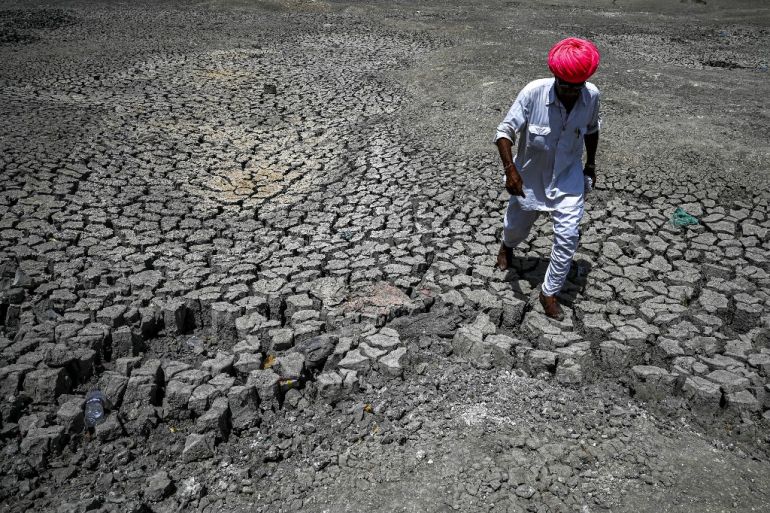India’s heat putting economy, development goals at risk: Study
The sizzling heat is underestimated by India’s legislators and officials as well as slowing the nation’s development, a study says.

Killer heatwaves are putting “unprecedented burdens” on India’s agriculture, economy and public health, with climate change undermining the country’s long-term efforts to reduce poverty, inequality and illness, a new study shows.
Extreme heat has caused more than 24,000 deaths since 1992 as well as driven up air pollution and accelerated glacial melt in northern India, according to the study, released on Wednesday by a team of scholars led by the University of Cambridge’s Ramit Debnath.
Keep reading
list of 4 itemsIndia’s heat action plans exclude the most vulnerable: Report
Future heatwaves will lead to large ‘loss of life’, report warns
‘No option’: Poor workers struggle amid India’s brutal heatwave
India is now “facing a collision of multiple, cumulative climate hazards”, with extreme weather happening almost every day from January to October last year, the study said. Extreme heat is placing 80 percent of India’s population of 1.4 billion in danger, it added.
The peer-reviewed study said the full extent of the damage from India’s sizzling heat, which is causing deaths, illnesses, school shutdowns and crop failures – as well as slowing the nation’s development – is underestimated by the country’s legislators and officials.
Debnath told the Reuters news agency it was “very important to figure out how we measure vulnerabilities to frequent extreme events”, with the Indian government’s own “climate vulnerability index” believed to underestimate the effect that longer, earlier and more frequent heatwaves will have on development.
As much as 90 percent of India’s total area now lies in extreme heat danger zones and the country is not fully prepared, he warned.
“India has already done quite a bit in terms of heat mitigation – they actually now recognise heatwaves as part of their disaster relief package,” he said. “But there’s a need to optimise the pace of these plans.”
“The adaptation measures that are being put on paper are quite substantial… and I think they have a very strong solid plan, but it’s how they are implemented.”
The researchers also warned that heatwaves were weakening India’s efforts to meet its “Social Development Goals”, a list of 17 United Nations objectives to cut poverty, hunger, inequality and disease.
Extreme heat could ultimately lead to a 15 percent decline in “outdoor working capacity”, reduce the quality of life of up to 480 million people and cost 2.8 percent of gross domestic product (GDP) by 2050, they said.
Falling productivity caused by extremely high temperatures could already be costing India 5.4 percent of its GDP, according to the Climate Transparency Report published by environmental groups last year.
India is already experiencing extreme temperatures this year, with some states in the midst of another heatwave.
On Sunday, at least 11 people died and several others fell ill while attending an outdoor event organised by the government of Maharashtra state on the outskirts of Mumbai. Temperatures on the day hit close to 38 degrees Celsius (100 Fahrenheit) with high levels of humidity, local media reported.
The eastern state of West Bengal has closed all schools and colleges this week due to scorching heat. February this year was recorded as the warmest month in India in 122 years.
The study “highlights that heat risk is an additional layer of risk that is emerging quite quickly”, said Aditya Valiathan Pillai, an associate fellow at New Delhi-based think tank, Centre for Policy Research.
Pillai recently studied India’s readiness to respond to extremely hot weather.
The new research does draw useful links between increasing heat and its consequences on India’s development, Pillai said, but the study’s datasets – which look only at temperatures in April last year – are limiting.
He said it is nevertheless encouraging to see more research on the consequences of heat on India’s population being published.
More states are burning up under extreme temperatures and already heat-stressed regions are experiencing a growing number of days in near-unliveable temperatures.
“For India as a whole, the threshold for adapting to heat and other climate impacts will be reached in a few decades from now,” said Pillai. “For some, especially the poor, these limits have already been reached.”